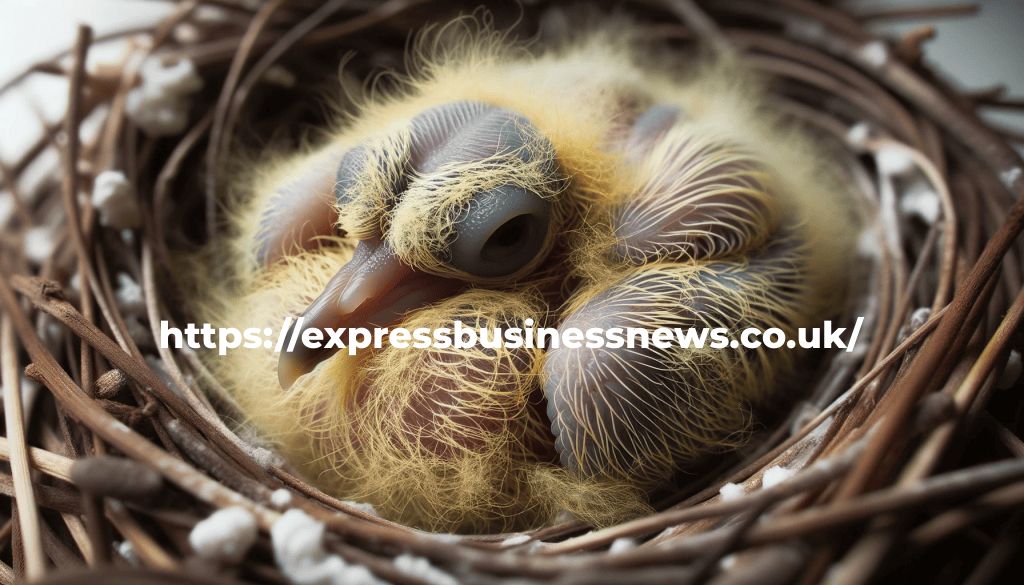Introduction To Baby Pigeon
Baby pigeons, often called squabs, are among the most elusive creatures in the urban environment. Despite their ubiquitous presence, they remain a huge element hidden from public view, important to many misconceptions and myths. In this text, we delve into the arena of small pigeons, exploring their life cycle, behavior, and the stressful conditions they face in the urban environment.
Appearance of Baby Pigeon
At first glance, baby pigeons can also appear bland, similar to adult pigeons but with a more fluffy and fluffy appearance. Their short stature and lack of precision skills predispose them to be easily neglected and blend seamlessly into their environment.
Habitat and nesting of Baby Pigeon
Pigeons are born and raised in nests built with the help of their father and mother. Pigeon nests are commonly placed on elevated sites, which include building ledges or under bridges that offer safety from predators. Nests are rudimentary systems made of twigs, leaves, and special dirt that provide minimal comfort but consistently serve their sanity.
Feeding habits
The diet of baby pigeons usually consists of pigeon milk, a nutrient-rich secretion produced by their parents. Pigeon milk is a regurgitated food that is fed to chickens and provides key nutrients for their growth and development. As they mature, baby pigeons transition to a seed and grain weight loss program, similar to adult pigeons.
Growth and development
Baby pigeons gain weight quickly, and their size doubles in the first week of life. Their improvement is manifested by employing a flourish of feathers, starting with down, which eventually gives way to individual plumage. Despite their rapid growth, pigeons remain in the nest for several weeks, depending on their father and mother for food and protection.
Behavioral properties
Baby pigeons exhibit much more than just a few developmental changes in behavior that may be necessary for their survival. They are quite loud, making soft coos to communicate with their parents. In addition, they show a strong bond with their parents, who are often close to them for warmth and protection.
Predators and threats
Despite their extraordinary efforts, small pigeons face numerous threats in the urban environment. Predators, which include cats, rats, and birds of prey, pose a huge threat to their survival. Additionally, human activities consisting of habitat destruction and pollutants similarly threaten their populations.
Adaptation
To sustain themselves in an urban environment, baby pigeons have developed several varieties. Their cryptic color allows them to blend in with their surroundings, making them much less noticeable to predators. They also have keen eyesight, which allows them to spot threats from a distance and make evasive moves.
Urban legends and myths
The elusiveness of the little pigeons has given rise to several urban legends and myths. One such myth is that baby pigeons do not exist now, with some people believing that pigeons grow fully grown from eggs. Another fallacy is that baby pigeons are born with the potential to fly, which is not true because they need many weeks of improvement before they can take off.
Conservation efforts
Although baby pigeons are a common sight in urban environments, they are not particularly targeted in conservation efforts. However, efforts to protect their habitat and reduce human interference may benefit their population. Providing nesting sites and minimizing disturbance can help ensure their continued survival.
Behavioral adaptation
Pigeons exhibit some behavioral variations that help them live in an urban environment. They are especially social birds that often form large flocks with different pigeons. This social behavior allows them to defend themselves from predators and to discover food extremely successfully. They are also noted for their homing intuition, which allows them to re-find their way to their nest even when they venture far from it.
Parental care
Parental care is essential for the survival of pigeons. Mother and father take turns incubating the eggs and feeding the chicks. The parents regurgitate food for the chicks and provide them with essential nutrients to thrive. In addition, they protect the chickens from predators and keep them warm during the bloodless climate.
Communication
Communication is an important thing in the life of a pigeon. They use some of the vocalizations to talk to each other and their mother and father. The soft cooing they emit is a form of communication that allows them to live in connection with their own family and coordinate their sports.
Physical development
The physical development of baby pigeons is breathtaking to behold. They start as helpless pups with closed eyes and sparse down feathers. As they grow larger, their down turns into personal feathers and they are shown to be extremely lively and impartial. Their physical improvement is a testament to their resilience and adaptability.
Impact on the environment
Baby pigeons, like several living creatures, affect their surroundings. For example, their droppings can be a source of vitamins for plant life and help fertilize the soil. However, in huge concentrations, pigeon droppings can be an additional nuisance and cause damage to homes and various structures.
Health and illness
Like any herbaceous world, baby pigeons are prone to many health problems and diseases. They can suffer from parasites consisting of mites and lice, as well as viral and bacterial infections. Urban environments can also expose them to pollutants and pollutants that can harm their health.
Role in pest control
Despite their often terrifying reputation, baby pigeons play a role in pest management in urban environments. They feed on beetles and their larvae and help keep insect populations under observation. This plant-based form of pest management can be beneficial to urban ecosystems.
Cultural significance
Pigeons have a long history of cultural significance, with references to them made in historical texts and works of art. In many cultures, pigeons are a symbol of peace, love, and freedom. At some point in history, they were also used as messengers to carry messages over long distances.
Future challenges
As the urban environment continues to intensify, toddlers face new traumatic situations. Loss of habitat, pollutants, and aversion to food are threats to their survival. Conservation efforts can be critical to ensuring the continued life of these breathtaking creatures in our urban landscape.
Patterns of behavior
Pigeons exhibit fascinating behavioral styles that may be key to their survival. They are especially adaptable birds that can adapt their behavior to the shape of their surroundings. For example, in urban areas, they were deployed using engines and buildings to defend themselves from predators and harsh climates. They are also believed to have strong homing instincts that help them navigate the complex urban landscape and find their way back to their nests.
Social structure
Baby pigeons are social creatures that live in flocks, often alongside tens or even hundreds of individuals. In these flocks, they form complicated social hierarchies, with dominant individuals often taking the lead in finding food and shelter. In addition, they engage in many social behaviors, including pretending to be everyone special and attractive during courtship.
Mating and reproduction of Baby Pigeon
The mating and replicating attitude of baby pigeons is a fascinating thing about their behavior. Pigeons are monogamous birds that form long-term pair bonds with their mates. During the breeding season, males court females by puffing out their chests and cooing loudly. Once a pair has mated, they form a nest together and raise their young.
Nesting behavior
Nesting behavior is an important detail of a pigeon’s existence. Pigeons are diagnosed for their ingenuity in nest-building phrases using a variety of substances that include twigs, leaves, and even bits of trash. They often choose advanced sites for their nests, which consist of building ledges or tree branches to protect them from predators.
Environment customization
Pigeons have developed some sorts of diversions that help them live and tell a story in an urban environment. For example, their mysterious color lets them into the surrounding environment, making them much less visible to predators. They have a great experience of hearing imagination, and foresight, which allows them to encounter threats to their ability and find the means to eat.
Feeding behavior
Feeding behavior is every other exciting detail in a baby pigeon’s life. They are opportunistic feeders, which means they will eat whatever is readily available to them. In urban areas, this often consists of leftover food left in return or through people. They are also believed to feed on seeds, grains, and small insects.
Migration and movement
While several pigeon populations are sedentary, others appear to make seasonal migrations. These migrations can cover hundreds or possibly hundreds of kilometers, with pigeons using a combination of visible landmarks and magnetic fields to navigate.
Interactions with other species
Pigeons meet several exceptional species in their environment. They are regularly hunted using birds of prey along with hawks and falcons, in addition to mammalian sources which include cats and rats. However, they also play a role within the environment as prey for animals that help maintain balance in the food chain.
Urban ecology
Understanding the ecology of small pigeons is essential to address their populations in urban environments. Pigeons are considered a city-tailored species, that is, they have effectively adapted to living in cities. However, their presence can cause conflicts with humans once in a while, especially when damaging houses or creating a mess.
Protection status
While baby pigeons are not considered an endangered species, their populations can suffer from human activity. Habitat loss, pollution, and clutter are potential threats to their survival. Conservation efforts aimed at protecting their habitats and minimizing human interference can help ensure their continued existence.
Research and study of Baby Pigeon
The study of baby pigeons can offer valuable insights into the behavior and ecology of urban flora and fauna. Researchers are using several techniques, including radio monitoring and genetic evaluation, to study pigeon populations and their movements. This research can help inform conservation efforts and urban planning techniques.
Educational Value
Observing small pigeons in their herbaceous environment can be a rare academic experience. It can help human beings develop an extraordinary respect for the plant world and wildlife that supplies our urban spaces. It can also encourage hobbies and a preference to analyze something extra about the area around us.
Conclusion
little pigeons, although regularly neglected, are first-class creatures that have successfully adapted to life in an urban environment. Their volatile nature and fascinating behavior motivate them to become a hobby for researchers and global herb enthusiasts alike. Despite several unpleasant conditions, which include habitat loss and pollution, baby pigeons thrive in the surrounding cities.





